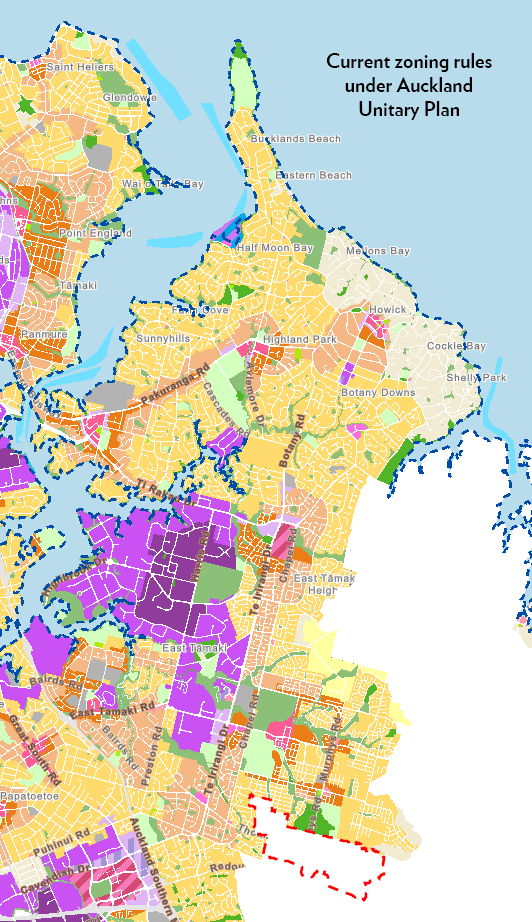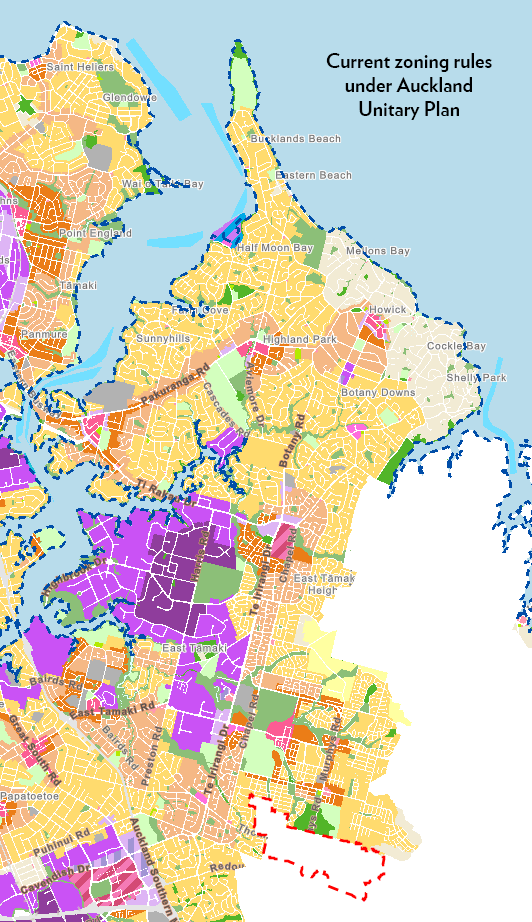Proposed rules for housing intenfisication open for feedback
We have an opportunity to provide feedback on the proposed changes to housing rules in Auckland that will guide increased intensification (known as Plan Change 78). There’s a lot to cover in the proposals and it can get quite technical so I’ll quickly cover what the changes are, how we got here, what it might mean for East Auckland and how you can engage with the process.
What are the changes?
There are two key changes that Auckland Council has to respond to:
National Policy Statement on Urban Development: enables buildings of six storeys or more within walking distances of our city centre, 10 large metropolitan centres (such as Newmarket, Manukau and New Lynn) and around rapid transit stops, such as train stations and stops on the Northern Busway.
Medium Density Residential Standards: enables more medium density housing of up to three storeys, such as townhouses and terrace housing, across almost all Auckland suburbs.
Councils are able to place some restrictions on these using what is called Qualifying Matters. Some of these are defined by the legislation and council has matched them to existing rules (known as overlays). However Auckland Council has also created some new qualifying matters which may or may not be accepted, which is a risky strategy. Matters like Auckland War Memorial Museum Viewshaft Overlay, Notable Trees and Māori Cultural Heritage are more likely to be accepted (especially given their limited impact). The more risky ones include Significant infrastructure constraints and Special character areas.
Significant infrastructure constraints.
We know there are parts of Auckland where the infrastructure cannot cope with current demands, flooding streets and homes when there is heavy rain. Beaches become unswimmable as waste floods into our harbours. As our city continues to grow these issues continue to compound, increasing the risk of serious, long-term environmental damage.
The risk is that this isn’t accepted based on the fact that this problem has been created by council. If it does go through, council must ensure that there is a strict and transparent process to ensure it is not abused. Areas that are identified as requiring limited development must have a robust plan developed to address the gaps, including timeframes and funding. Long-term and permanent use should be extremely rare and only where there is no other alternative.
Special Character Areas (SCAs)
These are areas that have been identified as being older, established suburbs that have special character value. Auckland Council is proposing to maintain approximately 70% of properties already covered by existing special character areas. Properties that have been identified to define or support the special character of an area are proposed to be subject to the demolition, removal and relocation rule, meaning a resource consent will be required for this activity as well as any replacement building.
I fully support the protection of heritage (environmental, cultural and historic) including buildings and places. However, the process that council has used to create Special Character zones is pretty loose - there is no good definition of what Special Character is and most of it is based on desktop assessments i.e. no one went to the site to assess the buildings. After all the work that has been done, it may get thrown out and leave some of our heritage with little protection.
How did we get here?
It’s important to note that these changes come from parliament - National and Labour teamed up to push through legistation requiring intensification, without consulting councils or the other parties. The Greens citicised the speed and lack of funding, but voted for it; Act voted against it but have since said they don’t expect it to be repealed.
I’ve been critical of the lack of consultation and the speed of the changes - the public was given very little time to submit to parliament on significant changes and councils were also not consulted prior. The changes are intended to unlock greater housing density (which done well can be good) but failed to provide the funding to deliver the infrastructure that we so desperately need. But the law has been passed and councils have no choice but to implement them (parliament has supreme authority in New Zealand).
What does this mean for East Auckland?
I’ve tried to capture some of the key impacts on East Auckland, although some of the rules are site specific so you’d need to check the exact property if you’d wanting the details.
Single house zone gone, replaced with medium density housing of up to three storeys through most suburbs.
Viewshaft protection for Stockade Hill is retained although it’s still not the full 360 that the community asked for.
Howick Village retains it’s business special character area requiring resource consents for significant changes to buildings covered by the special character.
No Special character residential areas for East Auckland (no change).
Botany Town Centre and Pakuranga Bus Station identified as walking catchments which enables six storeys or more.
Meadowlands, Highland Park and Pakuranga Plaza identified as town centres (Terrace Housing and Apartment Buildings or THAB) which enables up to five storeys.
Infrastructure Qualifying Matter limits intensification in Mellons Bay, Cockle Bay, Shelly Park, Highland Park, Pakuranga Plaza, Pakuranga Road and small part of Golflands (around Tiger Road).
Maunga viewshaft over Beachlands (The Parade and Hattaway Ave) to protect views of Rangitoto.
How do I learn more and submit?
All of the documents are located on the Auckland Council website under Plan Change 78: Intensification.
There is an interactive map where you can see the proposed changes plus some more information on OurAuckland: Time running out to submit on Auckland’s new intensification rules and OurAuckland: More housing for our growing city.
Submit your feedback here (look for the ‘Make Submission Online’)
Feedback for this change closes Wednesday 29 September so don’t wait too long. Your submission doesn’t need to be technical or address everything in the proposal - just include what you think is important.
There is extra support available for people who are unsure of how to submit - A Friend of Submitter:
We understand that RMA processes can be a little daunting, so we have appointed a 'Friend of Submitter' who is an independent advisor to help submitters.
The Friend of the submitter can help explain the process, advise you on lodging your submission, how to express your views, and what to do after lodging your submission.
This service is available throughout the submission period and in the lead-up to the hearings.
To contact the Friend of the Submitter for assistance please email friendofsubmitter@aecom.com or phone 021 349 521.
There is no cost for this service which is contracted and funded through the governments Environmental Protection Agency.








